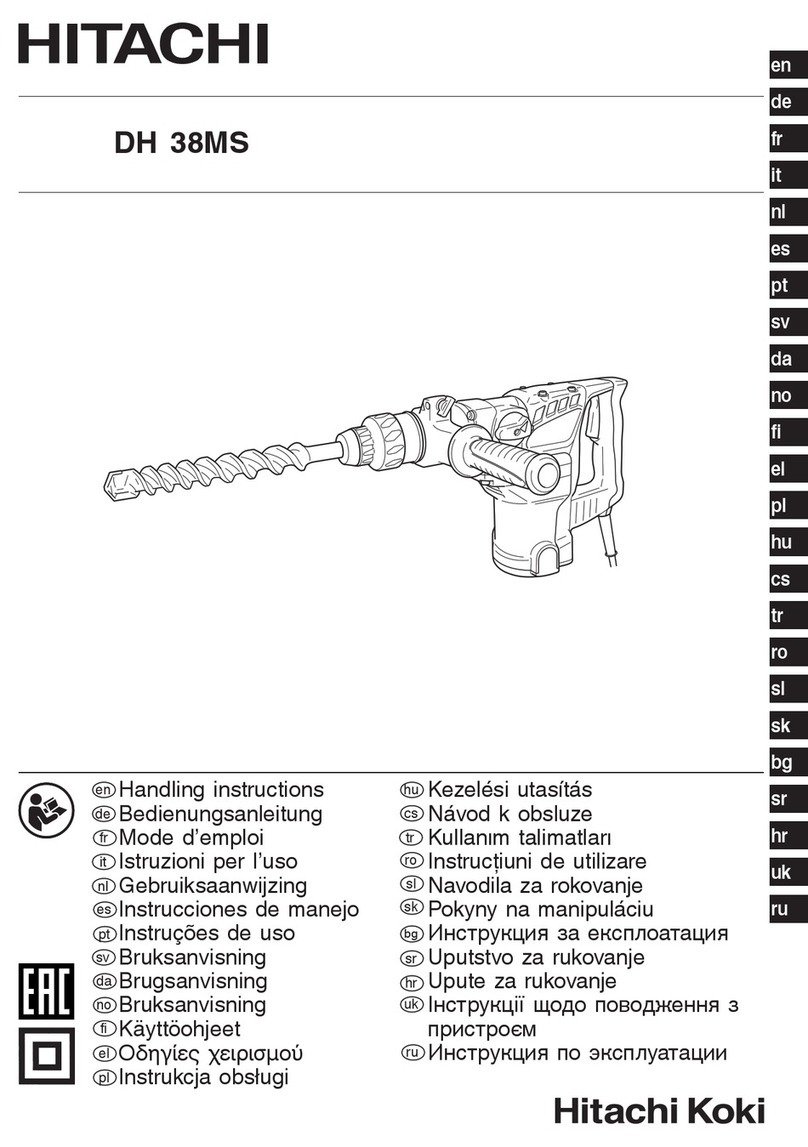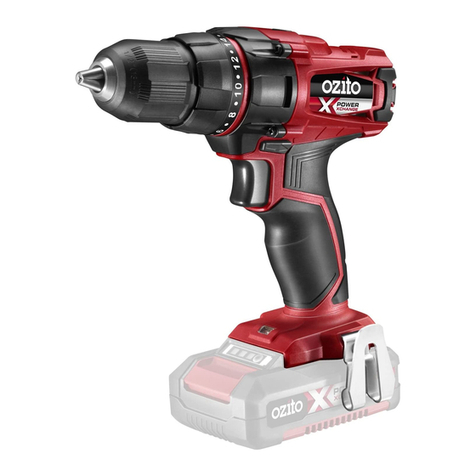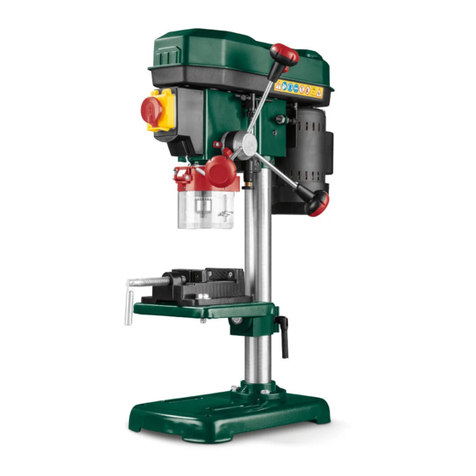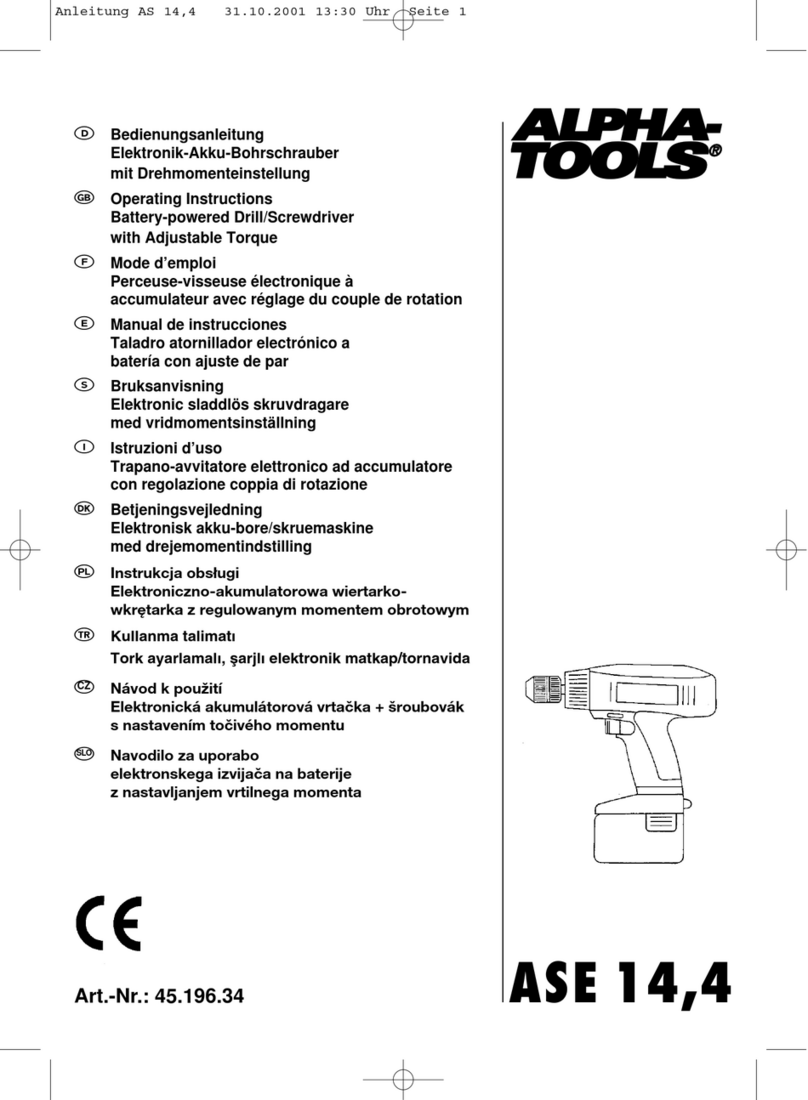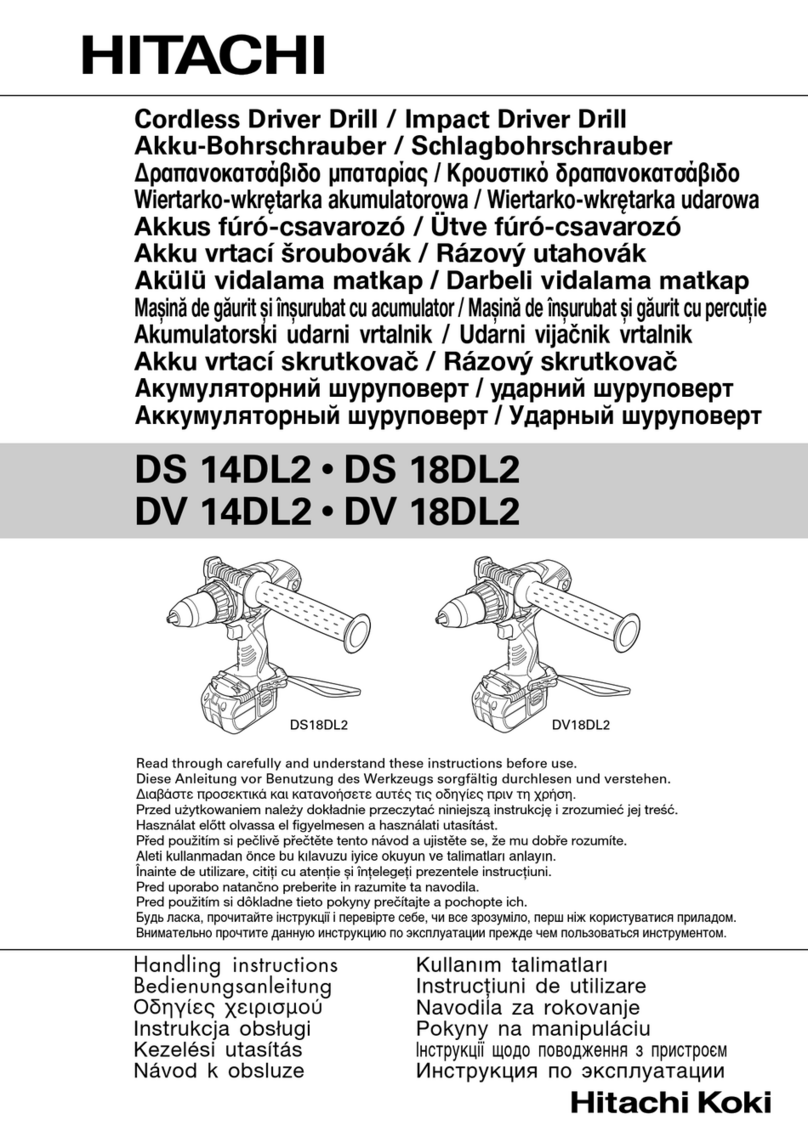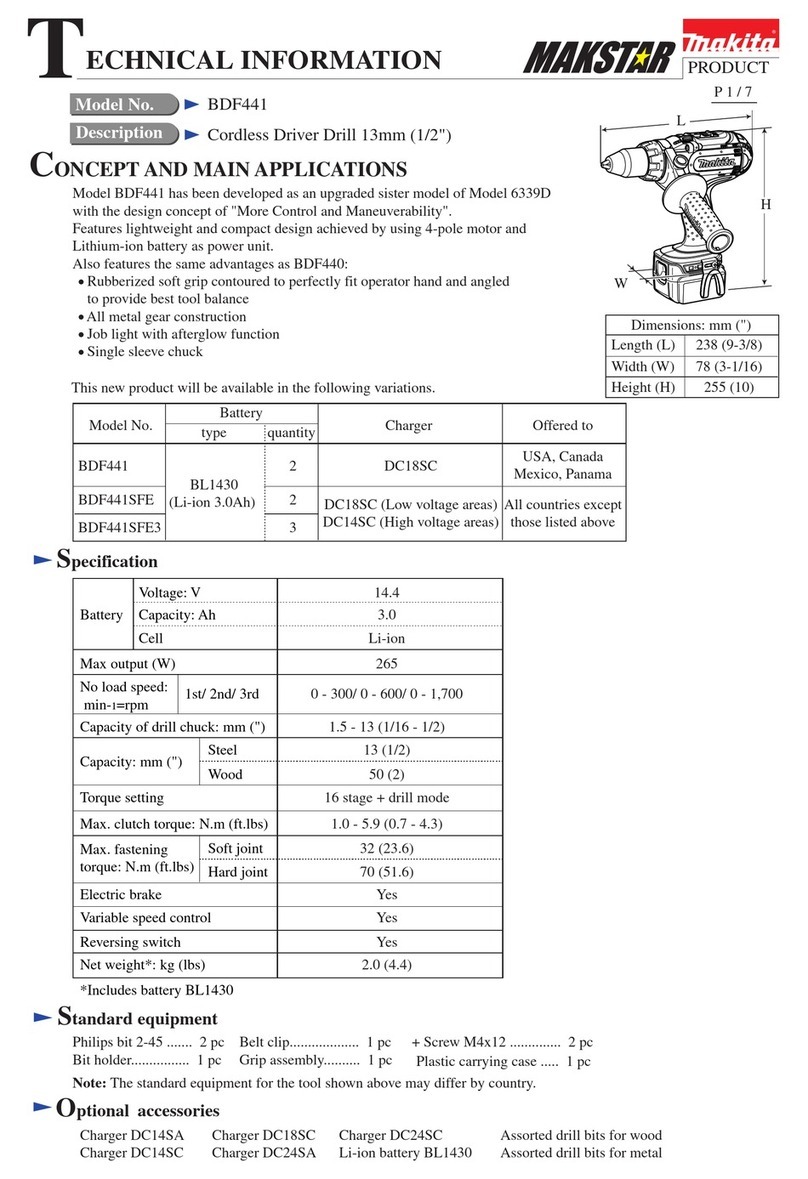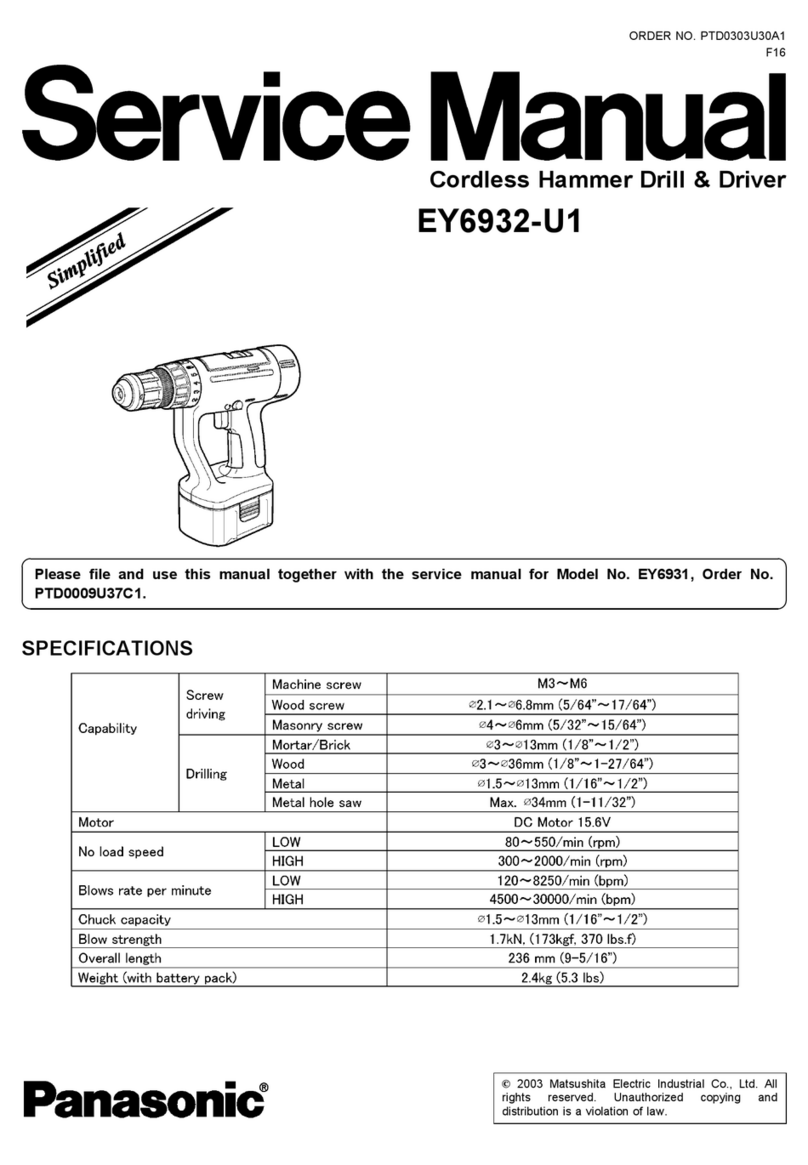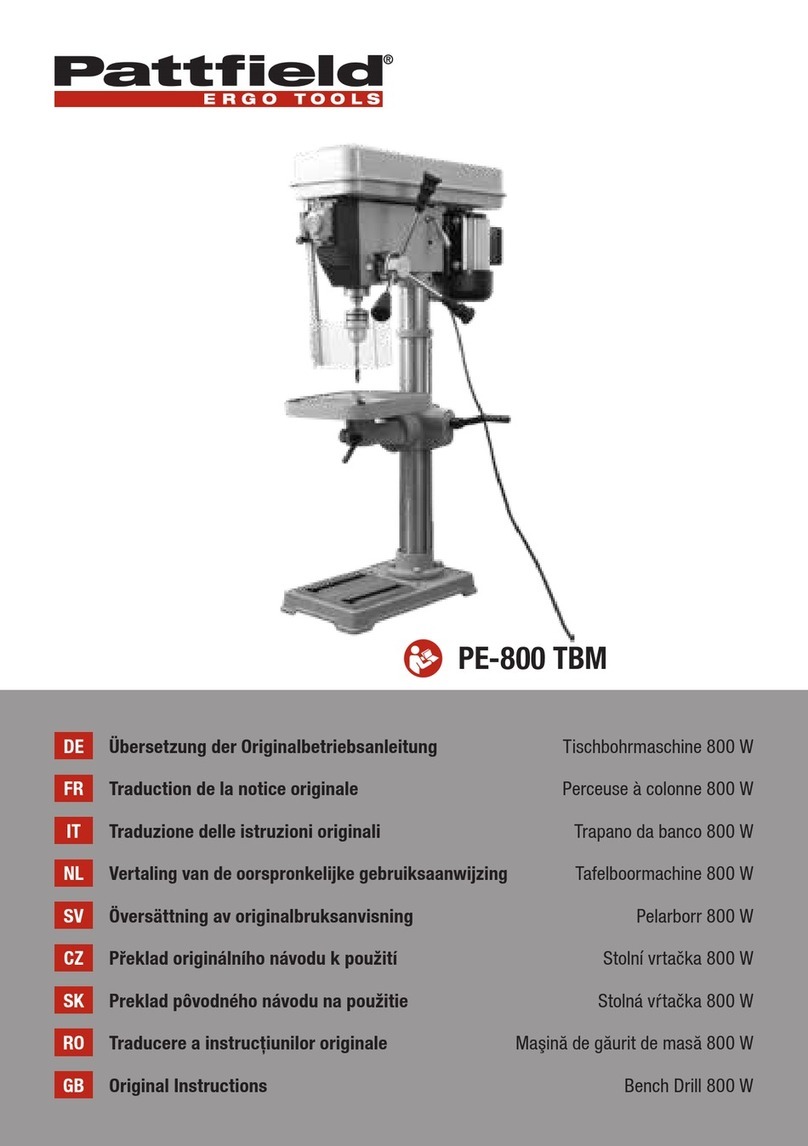Sovereign YT2115A User guide

550W IMPACT DRILL
Item No. 594458
Model No. YT2115A
HHGL Limited, MK9 1BA; HHGL (ROI) Limited, D02 X576 Mar 21
ORIGINAL INSTRUCTION MANUAL
Please read these instructions fully before starting assembly.
www.coreservice.co.uk
Technical Support & Parts
01904 727509
Mon-Fri 9am-5pm Sat-Sun 11am-4pm

2
CONTENTS
Contents 2
General safety warnings 3
Warning symbols 9
In the box 10
Operation 11
Maintenance and storage 17
Technical data 18
Recycling and disposal 20
UK plug 20
Getting help 21
Warranty 21

3
GENERAL SAFETY INFORMATION
WARNING! Read all safety warnings,
provided with this power tool.
Failure to follow all instructions listed below
injury.
Save all warnings and instructions for future
reference.
The term "power tool" in the warnings refers to your
mains-operated (corded) power tool or battery-
operated (cordless) power tool.
1) Work area safety
a. Keep work area clean and well lit. Cluttered or
dark areas invite accidents.
b. Do not operate power tools in explosive
atmospheres, such as in the presence of
flammable liquids, gases or dust. Power tools
create sparks which may ignite the dust or fumes.
c. Keep children and bystanders away while
operating a power tool. Distractions can cause
you to lose control.
2) Electrical safety
a. Power tool plugs must match the outlet. Never
modify the plug in any way. Do not use any
adaptor plugs with earthed (grounded) power

4
tools. Unmodified plugs and matching outlets will
reduce risk of electric shock.
b. Avoid body contact with earthed or grounded
surfaces, such as pipes, radiators, ranges and
refrigerators. There is an increased risk of electric
shock if your body is earthed or grounded.
c. Do not expose power tools to rain or wet
conditions. Water entering a power tool will
increase the risk of electric shock.
d. Do not abuse the cord. Never use the cord for
carrying, pulling or unplugging the power tool.
Keep cord away from heat, oil, sharp edges
or moving parts. Damaged or entangled cords
increase the risk of electric shock.
e. When operating a power tool outdoors, use an
extension cord suitable for outdoor use. Use of
a cord suitable for outdoor use reduces the risk of
electric shock.
f. If operating a power tool in a damp location
is unavoidable, use a residual current device
(RCD) protected supply. Use of an RCD reduces
the risk of electric shock.
3) Personal safety
a. Stay alert, watch what you are doing and
use common sense when operating a power
tool. Do not use a power tool while you are
tired or under the influence of drugs, alcohol

5
or medication. A moment of inattention while
operating power tools may result in serious
personal injury.
b. Use personal protective equipment. Always
wear eye protection. Protective equipment such
as dust mask, non-skid safety shoes, hard hat, or
hearing protection used for appropriate conditions
will reduce personal injuries.
c. Prevent unintentional starting. Ensure the
switch is in the 'off' position before connecting
to power source and/or battery pack, picking
up or carrying the tool. Carrying power tools
with your finger on the switch or energising power
tools that have the switch on invites accidents.
d. Remove any adjusting key or wrench before
turning the power tool on. A wrench or a key left
attached to a rotating part of the power tool may
result in personal injury.
e. Do not overreach. Keep proper footing and
balance at all times. This enables better control
of the power tool in unexpected situations.
f. Dress properly. Do not wear loose clothing or
jewellery. Keep your hair, clothing and gloves
away from moving parts. Loose clothes, jewellery
or long hair can be caught in moving parts.
g. If devices are provided for the connection of
dust extraction and collection facilities, ensure
these are connected and properly used. Use of
these devices can reduce dust-related hazards.

6
h. Do not let familiarity gained from frequent use
of tools allow you to become complacent and
ignore tool safety principles. A careless action
can cause severe injury within a fraction of a
second.
4) Power tool use and care
a. Do not force the power tool. Use the correct
power tool for your application. The correct
power tool will do the job better and safer at the
rate for which it was designed.
b. Do not use the power tool if the switch does
not turn it on and off. Any power tool that cannot
be controlled with the switch is dangerous and
must be repaired.
c. Disconnect the plug from the power source
and/or the battery pack from the power tool
before making any adjustments, changing
accessories, or storing power tools. Such
preventive safety measures reduce the risk of
starting the power tool accidentally.
d. Store idle power tools out of the reach of
children and do not allow persons unfamiliar
with the power tool or these instructions
to operate the power tool. Power tools are
dangerous in the hands of untrained users.
e. Maintain power tools. Check for misalignment
or binding of moving parts, breakage of parts
and any other condition that may affect the
power tool’s operation. If damaged, have the

7
power tool repaired before use. Many accidents
are caused by poorly maintained power tools.
f. Keep cutting tools sharp and clean. Properly
maintained cutting tools with sharp cutting edges
are less likely to bind and are easier to control.
g. Use the power tool, accessories and tool bits
etc. in accordance with these instructions,
taking into account the working conditions and
the work to be performed. Use of the power tool
for operations different from those intended could
result in a hazardous situation.
h. Keep handles and gripping surfaces dry, clean
and free from oil and grease. Slippery handles
and gripping surfaces do not allow for safe
handling and control of the tool in unexpected
situations.
Service
a) Have your power tool serviced by a qualified
repair person using only identical replacement
parts. This will ensure that the safety of the power
tool is maintained.

8
IMPACT DRILL SAFETY WARNINGS
1. Wear ear protectors when impact drilling.
Exposure to noise can cause hearing loss.
2. Use auxiliary handle(s), if supplied with the
tool. Loss of control can cause personal injury.
3. Hold power tool by insulated gripping surfaces,
when performing an operation where the
cutting accessory may contact hidden wiring or
its own cord. Cutting accessory contacting a "live"
wire may make exposed metal parts of the power
tool "live" and could give the operator an electric
shock.
4. Always be sure you have a firm footing. Be
sure no one is below when using the tool in high
locations.
5. Hold the tool firmly with both hands.
6. Keep hands away from rotating parts.
7. Do not leave the tool running. Operate the tool
only when hand-held.
8. Do not touch the bit or the workpiece
immediately after operation; they may be
extremely hot and could burn your skin.
9. Some material contains chemicals which may
be toxic. Take caution to prevent dust inhalation
and skin contact. Follow material supplier safety
data.

9
WARNING SYMBOLS
Warning!
Read the instructions
Wear ear protection
Wear eye protection
Wear a dust mask
Class II tool
The product complies with the applicable European
directives, and an evaluation method of conformity
for these directives was done.
Recycle unwanted materials instead of disposing
of them as household waste. All tools, hoses
and packaging should be sorted, taken to the
local recycling centre and disposed of in an
environmentally safe way.
The product complies with the applicable UK
directives, and an evaluation method of conformity
for these directives was followed.

10
IN THE BOX
Description
1. 13mm plastic chuck
2. Auxiliary handle
3.
4. Depth gauge
5.
6. Switch lock-on button
7. Variable speed switch
8. Power cord
Accessories
1pc Auxiliary handle
1pc Metal depth gauge

11
OPERATION
NOTE: Before using the tool, read the
instruction book carefully.
Intended Use
The machine is intended for impact drilling in brick, concrete
and stone, as well as for drilling in wood, metal and plastic.
Attach the auxiliary handle (FIG. A)
1. Loosen the auxiliary handlegrip by rotating it anticlockwise.
2. Slide the collar of the auxiliary handle over the chuck and
onto the auxiliary handle collar mount of the drill, and
rotate to the desired working position.
3. Secure the auxiliary handle by turning the auxiliary handle
grip clockwise; make sure that the teeth on the grip fit in
the protrusions on the handle collar.
WARNING! Always check and rotate the handle tightly
before using to avoid any accident.

12
Installing the depth gauge (FIG. B)
1. Loosen the auxiliary handle by turning it anticlockwise.
2. Insert the depth gauge into the hole in the side handle and
adjust so that the drill bit extends beyond the end of the
rod to the required drilling depth.
3. Lock the depth gauge in position by turning the auxiliary
handle clockwise.
On/Off switch
Depress the switch to start the tool, and release it to stop your
tool.
Switch lock-on button (FIG. C)
now locked on for continuous use. To switch off your tool, just

13
Variable Speed control (FIG. D)
Adjust the variable speed control to increase or decrease the
speed according to the material and accessory to beused (also
possible during no load operation). Low speed will provide low
torque and high speed gives higher torque.
Forward/reverse rotation control (FIG. E)
switch to the right position (as viewed from the front of the
drill). The rotation will now be a forwards rotation. Push
rotation will be a backwards rotation.
WARNING! Never change the direction of rotation
when the tool is rotating, wait until it has stopped.

14
Adjusting between hammer and drill mode of operation
(FIG. F)
1.
icon) to select the hammer mode.
2.
icon) to select the drill mode.
Note: When drilling in hammer mode, carbide tipped drill
bits should be used and the drill must be set to rotate in the
forward rotation.
Inserting a bit (FIG. G)
WARNING! Remove the plug from the mains supply
before carrying out any adjustment, servicing or
maintenance. Do not attempt to tighten drill bits (or
any other accessory) by gripping the front part of the
chuck and turning the tool on. Damage to the chuck
and personal injury may result.

15
To open the chuck jaws, rotate the front section of the chuck
while holding the rear section. Insert the drill bit between
the chuck jaws and rotate the front section in the opposite
direction while holding the rear section. Ensure that the drill
bit is in the centre of the chuck jaws. Finally, firmly rotate the
two separate chuck sections in opposite directions. Your drill
bit is now locked in the chuck.
Drilling in all materials
1. Always use sharp drill bits.
2. Mark the place where the hole is to be drilled.
3. Commence with a slow speed to start the hole then
increase the speed once the hole has been started. Reduce
your pressure on the tool when the drill bit is about to
break through the material.
Drilling in metal
1. Move the mode selector to the right (drill bit icon) to select
the drill mode.
2. Support thin material on a scrap piece of wood.
3. Use a punch to mark the position of the hole. Careful use
of the variable speed feature allows you to start holes
without centre punching. Operate the drill at a low speed
until you start the hole.
4. If drilling a large hole use a small drill bit at first to establish

16
a pilot hole then use the required large sized drill bit.
5. Use only HSS (high speed steel) drill bits or those
recommended for metal use.
6. When drilling into iron or steel, use a cooling lubricant,
such as thin oil.
7. With aluminium, use turpentine or paraffin.
8. With brass, copper and cast iron, use no lubricant but
withdraw the drill regularly to assist cooling.
Drilling in wood
1. Move the mode selector to the right (drill bit icon) to select
the drill mode.
2. Mark the place where you want to drill with a punch or nail.
3. To avoid splintering on breakthrough, either clamp a piece
of scrap wood to the back of the workpiece or continue the
hole from the back of the workpiece when the drill bit first
breaks through.
Hammer drilling in masonry
1. Move the mode selector to the left (hammer icon) to select
the hammer mode.
2. Hold the drill firmly and place the bit at the point to be
drilled.
3. Depress the switch to start the drill.
4. Move the drill bit into the workpiece, applying only enough
pressure to keep the bit cutting.
Note: Do not force the drill or apply side pressure to elongate
a hole. Let the drill and bit do the work.
5. If the bit jams in the workpiece or if the drill stalls, stop the
tool immediately. Remove the bit from the workpiece and
determine the reason for jamming.

17
MAINTENANCE AND STORAGE
IMPORTANT:
Make sure that the tool has been thoroughly cleaned
before storing it in a clean, dry and safe place, out of
the reach of children.
1. Switch the product 'OFF' and disconnect it from the power
supply before transporting it anywhere.
2. Always carry the product on its gripping surfaces.
3. Protect the product from any heavy impact or strong
vibrations; which may occur during transportation in
vehicles.
4. Secure the product to prevent it from slipping or falling
over.

18
TECHNICAL DATA
Model YT2115A
No-load speed
Blows per minute 48000BPM
Chuck capacity Max. 13mm
Protection class
Weight 1.8kg
Noise and vibration data
A weighted sound pressure (LpA) 92 dB(A), k=3dB(A)
A weighted sound power (LwA) 103 dB(A), k=3dB(A)
Vibrations
Drill into metal ah,D
2 2
Impact drill into concrete ah,ID
2 2
The sound intensity level for the operator may exceed 80
dB(A) and ear protection measures are necessary.
The declared vibration value has been measured in
accordance with a standard test method (according to EN
60745) and may be used for comparing one product with
another. The declared vibration value may also be used in a
preliminary assessment of exposure.
WARNING!
The vibration emission value during actual use of
the power tool can differ from the declared value
depending on the ways in which the tool is used and
dependant on the following examples and other
variations on how the tool is used: How the tool is
used and the materials being cut or drilled.
The tool being in good condition and well maintained.
Using the correct accessory for the tool and ensuring it
is sharp and in good condition.

19
The tightness of the grip on the handles and if any
anti-vibration accessories are used.
And the tool is being used as intended by its design
and these instructions.
This tool may cause hand-arm vibration syndrome
if its use is not adequately managed.
WARNING! To be accurate, an estimation of exposure
level in the actual conditions of use should also take
account of all parts of the operating cycle, such as
the times when the tool is switched off and when it is
running idle but not actually doing the job. This may
significantly reduce the exposure level over the total
working period.
Helping to minimise your vibration exposure risk.
ALWAYS use sharp chisels, drills and blades.
Maintain this tool in accordance with these instructions
and keep well lubricated (where appropriate).
If the tool is to be used regularly then invest in anti-
vibration accessories.
Plan your work schedule to spread any high vibration
tool use across a number of days.

20
RECYCLING AND DISPOSAL
Waste electrical products should not be disposed with
household waste. Please recycle where facilities exist.
Check with your local authority or retailer for recycling
advice.
UK PLUG
instructions below.
IMPORTANT: The wires in the mains lead are coloured in
accordance with the following code: Blue–Neutral, Brown–Live
WARNING! Never connect live or neutral wires to the
As the colours of the wire in the mains lead of this product
may not correspond with the coloured markings identifying
the terminals in your plug, proceed as follows: The blue wire
must be connected to the terminal marked N or coloured
black. The brown wire must be connected to the terminal
marked L or coloured red.
This manual suits for next models
1
Table of contents
Other Sovereign Drill manuals


